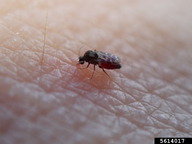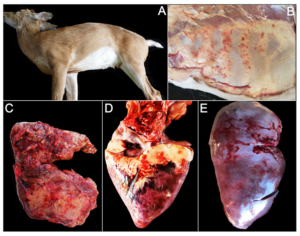
White-Tailed Deer and Epizootic Hemorrhagic Disease (EHD) in Michigan
Introduction
Epizootic Hemorrhagic Disease, commonly shortened to the acronym EHD, has recently been making headlines in Michigan due to recent reports of its presence. Education of wildlife diseases is especially important for recreationists like hunters during this time of year. Understanding diseases for the wildlife near you is critical for monitoring and it can be important to distinguish between similar but distinct diseases, such as the differences between bluetongue and EHD.
What is Epizootic Hemorrhagic Disease (EHD)?
The Michigan Department of Natural Resources (DNR) qualifies EHD as an infectious virus with a high mortality rate in wild ruminants such as white-tailed deer. However, EHD occasionally occurs in other species such as mule deer and pronghorn antelope. Undetermined diagnosis and similar diseases have been detected in deer since 1890, however, the first cases of EHD in Michigan deer were described in 1955.
How is EHD Spread?

Culicoides spp. on a human. Courtesy of Whitney Cranshaw, Bugwood.org.
EHD is transmitted when an infected midge vector bites a deer per the MDNR. The disease is not noted to be transmitted from an infected deer horizontally to other individuals or species. However, artificial inoculation of viral material can be transmitted to an uninfected deer via various routes during experimentation. Midges lay eggs in exposed mud near water sources, increasing the risk of EHD transmission for deer near these areas. There is a noted seasonality in documented cases of the disease occurring August to October where the insect vector dies from frost.
Recognizing EHD

Farmed White-tailed Deer naturally infected with EHD, by Rodrigues, Thaís et al., used under CC BY 4.0.
Distinguishing between EHD and other diseases can be complex and hard to verify. The virus is typically latent for 7 days after exposure with sudden onset and death after 8 to 36 hours. Identifiable clinical signs include appetite loss, weakness, excessive salivation, decreased fear of humans, rapid pulse and breathing. Infected and deceased deer can be found near water as they seek temperature regulation from feverish symptoms. Internally, the blood of a deer has a lack of oxygen and hemorrhage leading to a blue appearance. Internal organs can commonly have hemorrhaging defined as pinpoint and widespread. It is important to identify contributing factors professionals use to diagnose diseases such as observable signs and lesions, season, and the presence of the virus in infected tissues.
Impacts on Michigan
Michigan’s hunting culture surrounding white-tailed deer allows diseases impacting herd size to be detrimental for deer hunters. There is a list of deer population die-offs classified as EHD on the Michigan DNR website since 1974 describing year and reported counties. The virus has the ability to impact domestic hoof stock but rarely lead to disease. The Michigan DNR reports confirmed cases have reached 11 counties in southwest Michigan since early September. Currently, the Michigan DNR has identified no cases of disease transmission to humans or pets via infected midge or contact/consumption with an infected deer.
Moving Forward
There is currently no treatment or control method identified, however there are possible vaccination avenues to explore in the future. If you are in the field and happen to see a bird or mammal you believe may have died from disease, submit an observation to the Eyes in the Field report from the DNR.
For more information about EHD in Michigan, visit the DNR website HERE.
